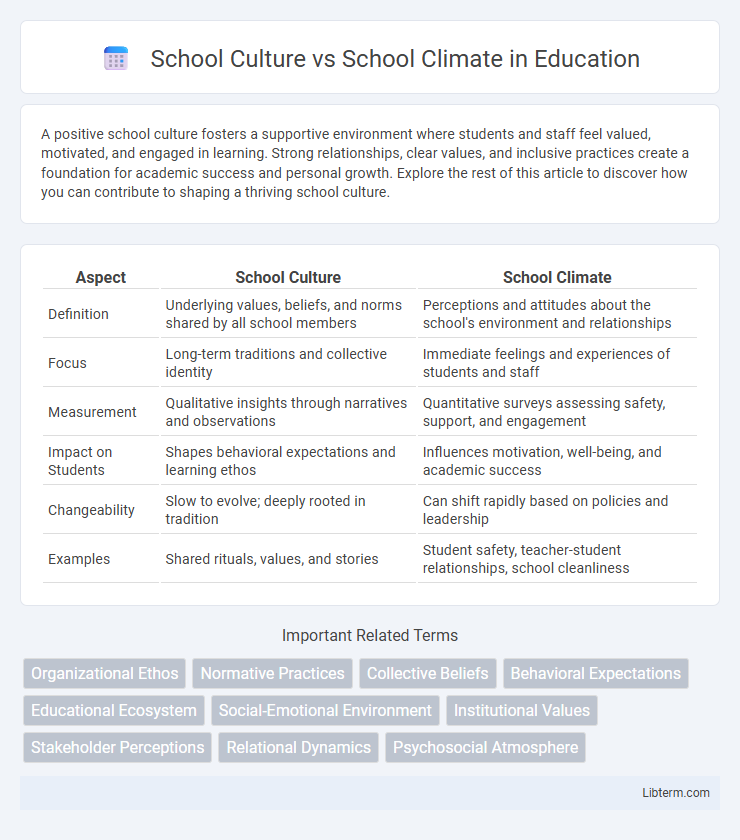A positive school culture fosters a supportive environment where students and staff feel valued, motivated, and engaged in learning. Strong relationships, clear values, and inclusive practices create a foundation for academic success and personal growth. Explore the rest of this article to discover how you can contribute to shaping a thriving school culture.
Table of Comparison
| Aspect | School Culture | School Climate |
|---|---|---|
| Definition | Underlying values, beliefs, and norms shared by all school members | Perceptions and attitudes about the school's environment and relationships |
| Focus | Long-term traditions and collective identity | Immediate feelings and experiences of students and staff |
| Measurement | Qualitative insights through narratives and observations | Quantitative surveys assessing safety, support, and engagement |
| Impact on Students | Shapes behavioral expectations and learning ethos | Influences motivation, well-being, and academic success |
| Changeability | Slow to evolve; deeply rooted in tradition | Can shift rapidly based on policies and leadership |
| Examples | Shared rituals, values, and stories | Student safety, teacher-student relationships, school cleanliness |
Defining School Culture and School Climate
School culture encompasses the shared beliefs, values, traditions, and practices that shape the overall environment and identity of a school community. School climate refers to the day-to-day emotional and social tone experienced by students and staff, including safety, relationships, and support. Both factors critically influence student engagement, academic achievement, and faculty collaboration but operate on different levels within educational settings.
Key Differences Between School Culture and School Climate
School culture encompasses the shared beliefs, values, and norms that shape the behavior and attitudes of students, teachers, and staff within the educational environment. School climate refers to the overall atmosphere experienced by the school community, including safety, relationships, and learning conditions. Key differences include culture being deeply ingrained and long-lasting, while climate is more dynamic and can change based on policies or leadership.
The Role of Leadership in Shaping School Culture
Leadership profoundly influences school culture by establishing core values, setting behavioral expectations, and modeling professional ethics that permeate throughout the educational environment. Effective leaders foster collaboration, trust, and shared vision among staff and students, which cultivates a positive and supportive culture conducive to learning. Strategic decision-making and consistent communication from leadership help embed cultural norms that sustain long-term organizational growth and student success.
How School Climate Influences Student Outcomes
School climate significantly influences student outcomes by shaping feelings of safety, support, and belonging within the educational environment. Positive school climate fosters higher academic achievement, improved attendance, and reduced behavioral issues through enhanced student engagement and motivation. Research consistently shows that schools with a nurturing climate promote social-emotional development and overall well-being, directly impacting learning success and student retention.
Components of a Positive School Culture
A positive school culture is characterized by shared values, beliefs, and norms that promote respect, collaboration, and a sense of belonging among students and staff. Key components include strong leadership, supportive teacher relationships, clear communication, and a commitment to student success and well-being. Emphasizing inclusivity, continuous professional development, and community engagement fosters an environment conducive to academic achievement and personal growth.
Measuring and Assessing School Climate
Measuring and assessing school climate involves collecting data on students' perceptions of safety, relationships, and learning environment through surveys and focus groups. Tools like the Comprehensive School Climate Inventory (CSCI) provide empirical evidence to evaluate social-emotional support and physical safety within schools. Accurate assessment of school climate helps identify areas for improvement, directly impacting student engagement and academic achievement.
Impact of School Culture on Teacher Retention
School culture, defined by shared beliefs, values, and practices within an educational institution, profoundly influences teacher retention by fostering a supportive and collaborative environment that enhances job satisfaction. Positive school culture encourages professional growth, mutual respect, and a sense of belonging, reducing burnout and turnover rates among teachers. Research highlights that schools with strong, inclusive cultures experience higher teacher commitment and long-term retention compared to those with weak or negative cultures.
Strategies to Improve School Climate
Strategies to improve school climate include fostering positive relationships among students, staff, and families through consistent communication and respect-based activities. Implementing restorative practices and social-emotional learning programs promotes safety, inclusivity, and emotional well-being in the school environment. Data-driven approaches, such as climate surveys and feedback loops, help educators identify areas for growth and celebrate successes to continuously enhance the overall school atmosphere.
The Interplay Between Culture and Climate in Schools
School culture and school climate interact dynamically, shaping the educational environment and influencing student outcomes. School culture encompasses the shared values, beliefs, and practices that define the school community, while school climate reflects the perceptions and experiences of safety, relationships, and support among students and staff. Understanding their interplay helps educators foster a positive, inclusive atmosphere that promotes academic achievement and social-emotional well-being.
Case Studies: Transforming School Culture and Climate
Case studies on transforming school culture and climate reveal that intentional leadership and community engagement significantly improve student outcomes and staff satisfaction. Schools that implemented restorative practices and inclusive policies saw notable decreases in disciplinary incidents and increases in academic achievement. Data-driven approaches to assess and modify underlying values and behaviors foster environments where both school culture and climate positively align to support holistic development.
School Culture Infographic

 libterm.com
libterm.com